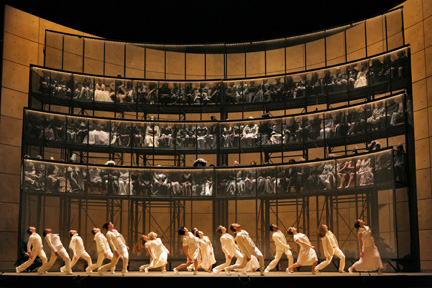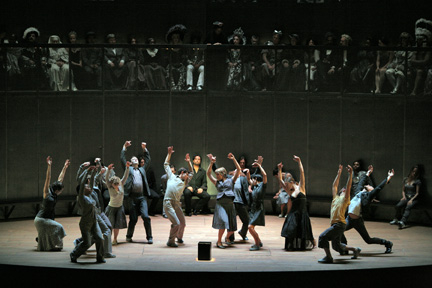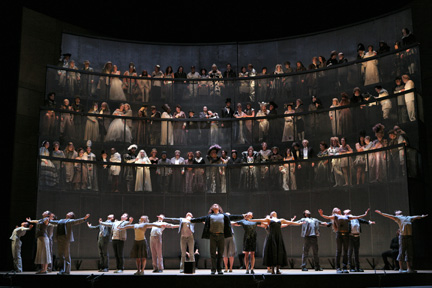Mark Morris's "Orfeo ed Euridice"
“Orfeo ed Euridice”
Directed and choreographed by Mark Morris
Metropolitan Opera
Metropolitan Opera House
New York, NY
May 5, 2007
by Susan Reiter
copyright © 2007 by Susan Reiter
 Mark Morris’ new production of Gluck’s gorgeous 1762 opera is filled with images of eloquent simplicity. Not for a moment did the stage picture feel spare, but there was also not a moment of excess, nothing to distract from the emotional momentum of the work. The presiding concept was that of grace — an ennobling purity and restraint. Morris employed 18 members of his company (plus four men from the Met’s dance roster) not only for spirited, elegantly crafted sequences during the score’s extensive dance music, but also in resonant choral patterns to echo and amplify Orpheus’ sufferings.
Mark Morris’ new production of Gluck’s gorgeous 1762 opera is filled with images of eloquent simplicity. Not for a moment did the stage picture feel spare, but there was also not a moment of excess, nothing to distract from the emotional momentum of the work. The presiding concept was that of grace — an ennobling purity and restraint. Morris employed 18 members of his company (plus four men from the Met’s dance roster) not only for spirited, elegantly crafted sequences during the score’s extensive dance music, but also in resonant choral patterns to echo and amplify Orpheus’ sufferings.
Allen Moyer’s set emphasizes the expansive scale — in particular the height — of the Met stage. The 100-strong chorus is seated on two massive, very tall set pieces, each with three rows, that form an arc framing the central action. Looming above, they resemble spectators in a vast operating theater, or can be seen as sitting in judgment from on high. They are costumed as significant historical figures and representatives; I spotted a pope, a nun, Mahatma Gandhi, a Native American in tribal dress and Abraham Lincoln, amid the striking rows that included gowns with large, diaphanous skirts and every other conceivable period dress. Massed together and often in muted light, they were not always fully visible in all their detail, the intended effect of witnesses from throughout history made its impact.
In the opening scene, where the focus is on Euridice’s funeral urn, placed downstage center, the dancers, wearing contemporary clothes in shades of grey, move with gravitas and restraint but are often caught in stillness, as they are arrayed on two benches in front of the large set pieces. As Orpheus (the fervent, dignified David Daniels, wearing a black jacket and pants) laments his loss, they occasionally come forward to lend support, and Morris has designed strikingly eloquent patterns form the simplest and most economical of means. Here, as one often does with Morris’ work, one senses a kinship with the deeply humanitarian communal emphasis of early modern dance choreographers — the strength and fervor of the dancers’ assembled impact. The four non-company men, severe figures in black, hover more in the background, occasionally escorting or guiding Orpheus. The chorus adds its own movement, as row by row they perform hands gestures that create a ripple effect of activity through their massed presence.
 The arrival of Amor features a touch of whimsy (and one recalls Morris’ own delicious turn as a winged Cupid in 1993's "A Spell") as the sprightly Heidi Grant Murphy descends from on high sporting a pink t-shirt speckled with sparkles, khakis and sneakers, along with the requisite wings. Suspended in mid-air, she offers Orpheus his opportunity to be reunited with his love, under strict conditions (“are you brave enough for such a trial?” the translation reads in the Met Titles), then starts to rise but has moment’s hesitation and descends for her aria.
The arrival of Amor features a touch of whimsy (and one recalls Morris’ own delicious turn as a winged Cupid in 1993's "A Spell") as the sprightly Heidi Grant Murphy descends from on high sporting a pink t-shirt speckled with sparkles, khakis and sneakers, along with the requisite wings. Suspended in mid-air, she offers Orpheus his opportunity to be reunited with his love, under strict conditions (“are you brave enough for such a trial?” the translation reads in the Met Titles), then starts to rise but has moment’s hesitation and descends for her aria.
The transition to the next scene, the Gates of Hades, is marked by the set’s two halves sliding apart. The dancers trudge with weighted emphasis in a line, each one’s arm on the shoulder’s of the one in front. As the chorus, in near-darkness and embodying the Furies, sings angrily in a churning rhythm, the dancing incorporated staggered jumps, slides and forceful arm movements. Now carrying a guitar (slung across his back with a sparkly black strap) — possibly as a nod to the charismatic central figure of Tennessee Williams’ “Orpheus Descending” — Orpheus enters through the open space left between the two set pieces to confront the angry spirits, engaging their empathy for his plight by appealing to their shared sense of grief. Morris keeps the movement spare and anything but hysterical in this Furies’ scene.
An endlessly long zig-zagging stairway that descends from the flies, that serves as Orpheus’ means of descent to the Underworld, proves more distracting than dramatically useful. For one thing, it sinks, through a trap, below the stage, then is in upward motion as Orpheus climbs down a couple of flights. As he makes this journey, the dancers, now in white, perform a very abbreviated sequence to the familiar Dance of the Blessed Spirits, circling as they sway and bend, creating a sense of infinite community. The set glows warmly, with pale panels appearing upstage. A luminous, calm triple duet, full of gentle partnering and leisurely unfolding moves, suggests the turn from grief to hope. As the dancers has served to reinforce the depth of Orpheus’ grief, they also embody the force of his love and his will to regain Euridice.
 For the crucial extended scene of Orpheus leading Euridice back from the realm of death, agonizing because he is forbidden to look at her or explain why he can’t, the set revolves 180 degrees so that all we had seen before is hidden, and the stage is filled with a dark curving wall representing an ominous rocky promontory, and the couple seems ot stand in a clearing carved into the rock. The intense passion and expressiveness of the stunning Maija Kovaleska, as Euridice, makes clear how much is at stake for Orpheus, and their exchanges, despite restricted movement of the scene, convey the essential heart of this drama.
For the crucial extended scene of Orpheus leading Euridice back from the realm of death, agonizing because he is forbidden to look at her or explain why he can’t, the set revolves 180 degrees so that all we had seen before is hidden, and the stage is filled with a dark curving wall representing an ominous rocky promontory, and the couple seems ot stand in a clearing carved into the rock. The intense passion and expressiveness of the stunning Maija Kovaleska, as Euridice, makes clear how much is at stake for Orpheus, and their exchanges, despite restricted movement of the scene, convey the essential heart of this drama.
When Orpheus falters and turns to look at her, she arches backward into the arms of the four men in black, who have become grim emissaries. But Amor once again brings not only bright color but hope to the stage, allowing Euridice to be restored to life to join Orpheus, leading to the joyful, festive final scene at the Temple of Love. Here the dancers are the primary focus entering with bounding vigor in clusters of three or four through the space between the two imposing set pieces, wearing brightly colored versions of their earlier costumes, and radiating sociability and radiant joy. The dances, to a series of short musical selections (several of them familiar from Balanchine’s “Chaconne,” which derives from a version of this opera he staged for the Hamburg State Opera in 1963), incorporate a communal folk spirit — playful and jaunty — as well as gentle, fluid ballet-derived movements. Here and there, a woman is lifted and carried aloft on the arms of two men. The stage pictures are charming, beguiling, and at times reminiscent of other bountifully harmonious choreography Morris has created to Baroque music. They also reverberate with some of the same slyly modern nods to antiquity that marked the third act of his “Sylvia.” In this conclusion, joyful celebration are expressed fully but with the same restraint and clarity that sorrow and lamentation had filled the stage at the start.
Photos by Marty Sohl.
Volume 5, No. 19
May 7, 2007
copyright ©2007 by Susan Reiter
www.danceviewtimes.com